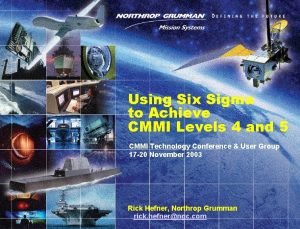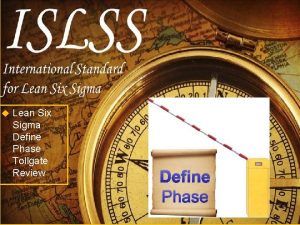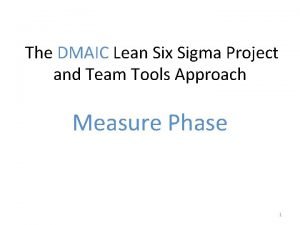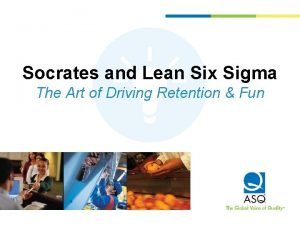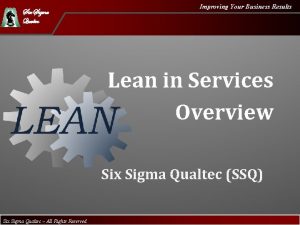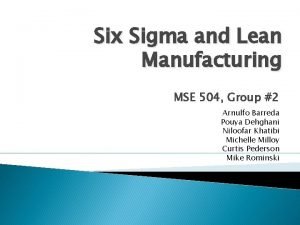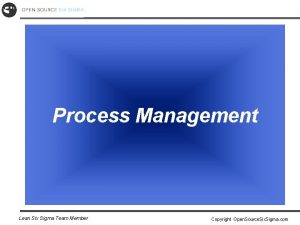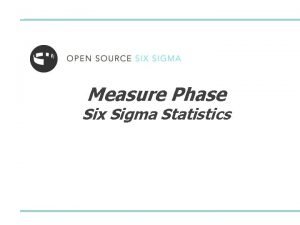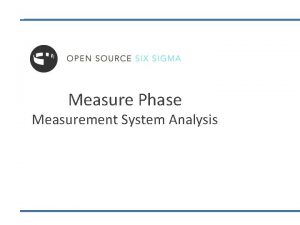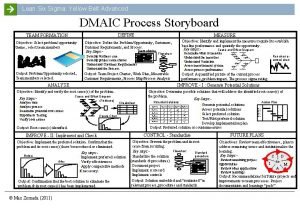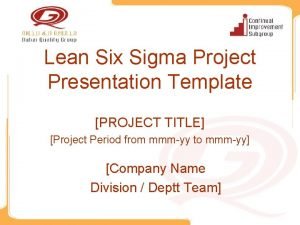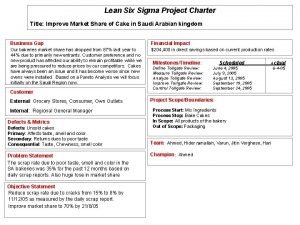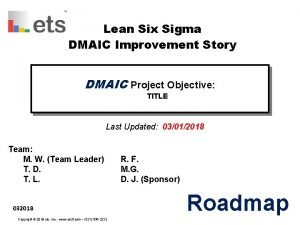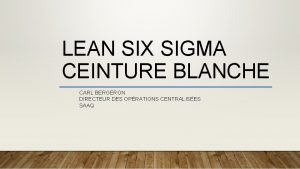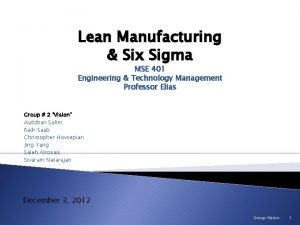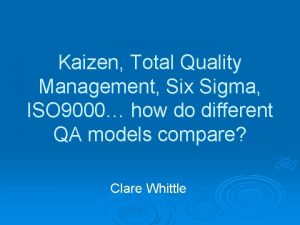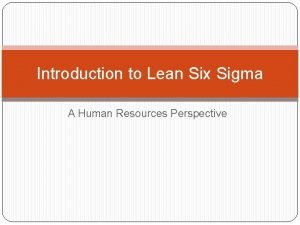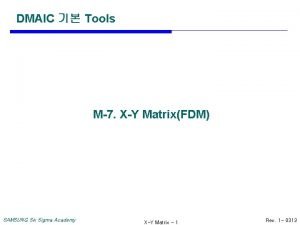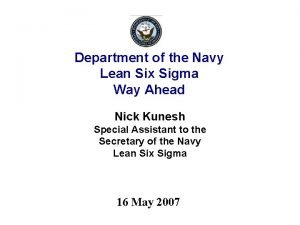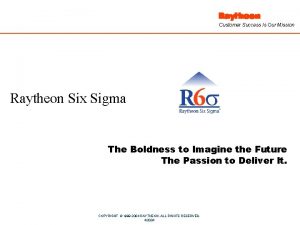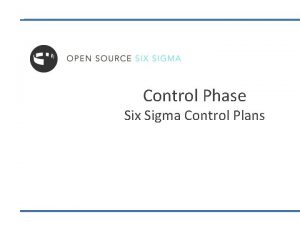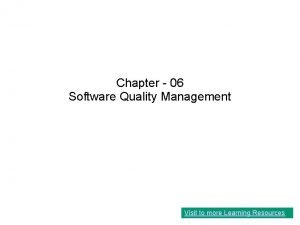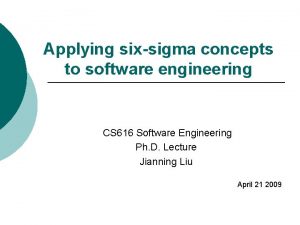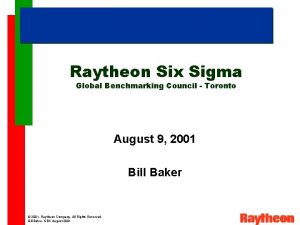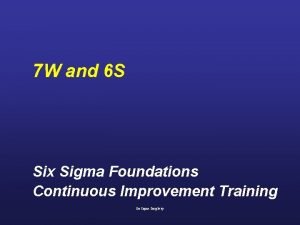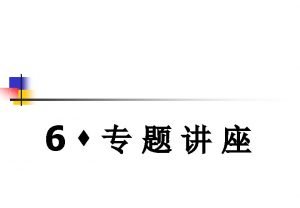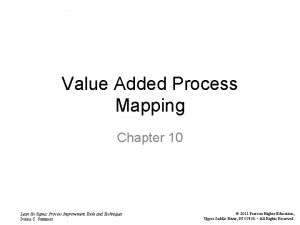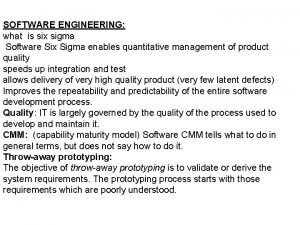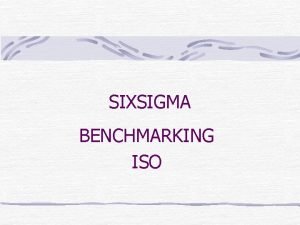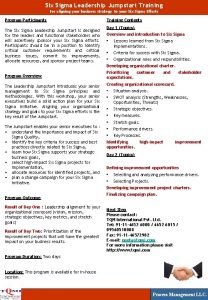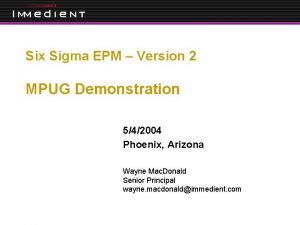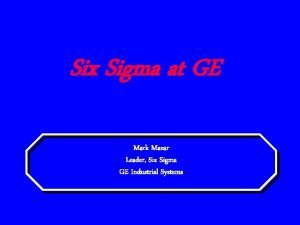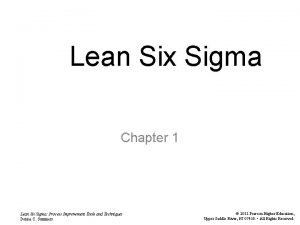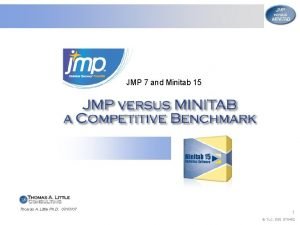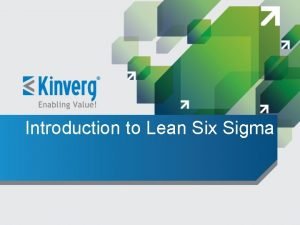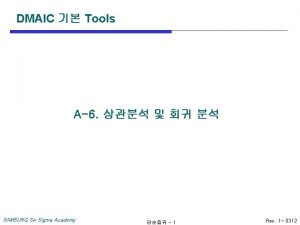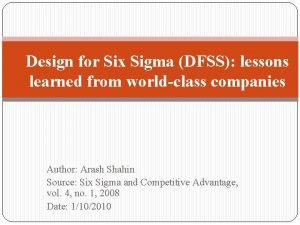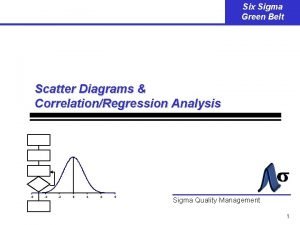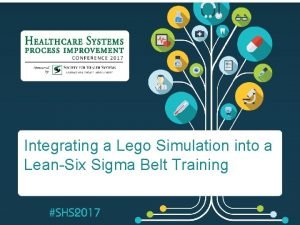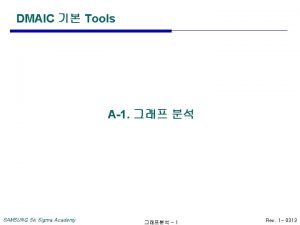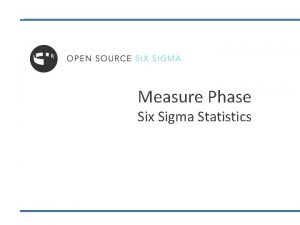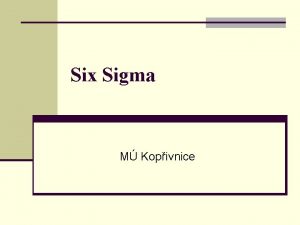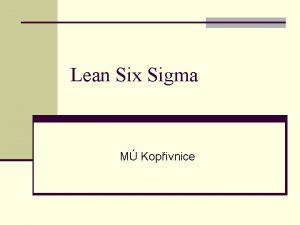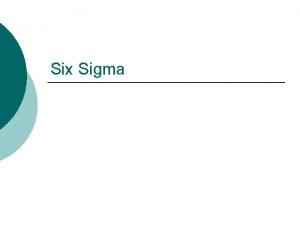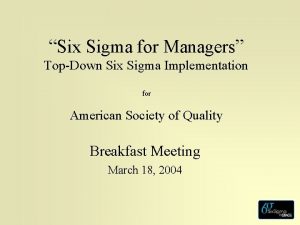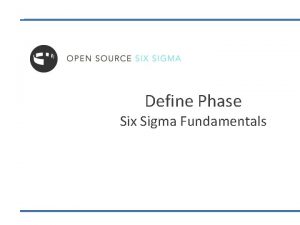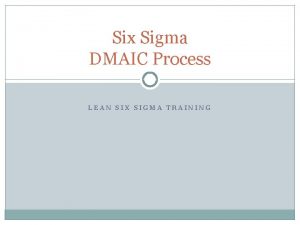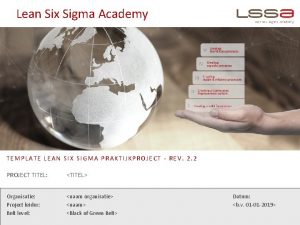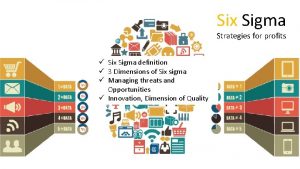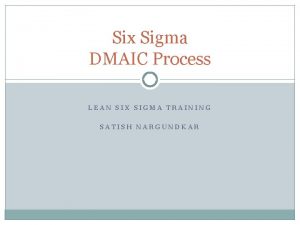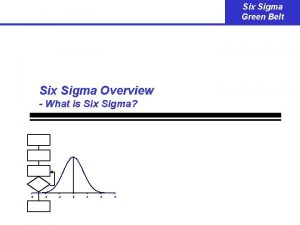Six Sigma Concept Section 1 Six Sigma An





















































- Slides: 53

Six Sigma Concept






Section 1 Six Sigma : An Overview

What is Sigma?



Where Does Industry Stand? PPM 1, 000 IRS - Tax Advice (phone-in) (140, 000 PPM) 100, 000 Restaurant Bills Doctor Prescription Writing Payroll Processing Order Write-up Journal Vouchers Wire Transfers Airline Baggage Handling 10, 000 • • 1, 000 100 Purchased Material Lot Reject Rate Best-in-Class 10 Average 1 1 Domestic Airline Flight Fatality Rate (0. 43 PPM) Company 2 3 4 Sigma Scale of Measure 5 6 7



Six Sigma �������� Process Capability PPM Defects per Million Opp. Sigma is a statistical unit of measure that reflects process capability. The sigma scale of measure is perfectly correlated to such characteristics as defects -per-unit, parts-per-million defective, and the probability of a failure/error.


Section 1 Six Sigma : An Overview

����� Six Sigma - Started on 1960 s’, a number of big companies were toying with the idea of Zero Defect (ZD). But the ideas didn’t go very far and limited to motivational slogans and pep talks. - On 1980 s’, giant companies spearheaded again the comeback of ZD philosophy. They are now more serious on producing defect free products. - For instant, Xerox with “Leadership Through Quality”, Intel with “PDQ 2”, HP with “TQC”, IBM with “Excellent in Execution” etc. . - Motorola didn’t want to miss the pack by establishing “ 6 -Sigma” program on 1987. The idea was first discovered by Mikel Harry, one of Motorola's finest employees from Government Electronics Group. - By giving itself 5 years time limit to achieved from 3 to 6 -Sigma, Motorola has spent merely 20 million dollar in its first year alone. Motorola's investment paid off and proved that ZD was achievable. - On the following years, Mikel Hurley left Motorola and set up his own company known as “Six Sigma Academy”, USA.

�������� Six Sigma ¨ Motorola n ¨ Texas Instruments n ¨ ABB n ¨ Allied Signal n ¨ General Electric n ¨ Seagate Technology n Du. Pont Sony Kodak Toshiba Lockheed Martin Other

Section 2 Six Sigma Process

Process Variation Inputs Process Output q All businesses consist of interconnected processes q Variation exist in all processes q Understanding and reducing process variability in the key to improve customer satisfaction and reducing losses

Focus of Six Sigma KPIV KPOV Y= f (X) To get results, should we focus our behavior on the Y or X? n n n Y Dependent Output Effect Symptom Monitor n n n X 1. . . XN Independent Input-Process Cause Problem Control If we are so good at X, why do we constantly test and inspect Y? Focus on X rather than Y, as done historically *

Process Output Variation 1 2 3 m 5 6 s m : measurement of location : measurement of variability 7

Process Sigma Level Definition : The number of standard deviation that can be fitted into the space between the process center and the nearest specification limits LSL Nominal USL Fit for use Defectives m

6 Sigma Process LSL USL 0. 002 ppm (2 tails) Process center on target m LSL USL m 3. 4 ppm after 1. 5 s drift from process center

What does a 6 sigma process look like ? m Average Deviation from Mean 1 T 1 p(d) 2 3 s 4 5 6 USL 3 This is a 6 Sigma Process

Six Sigma - Practical Meaning 99% Good (3. 8 Sigma) 99. 99966% Good (6 Sigma) 20, 000 lost articles of mail per hour Seven articles lost per hour Unsafe drinking water for almost 15 minutes each day One unsafe minute every seven months 5, 000 incorrect surgical operations per week 1. 7 incorrect operations per week Two short or long landings at most major airports each day One short or long landing every five years 200, 000 wrong drug prescriptions each year 68 wrong prescriptions per year No electricity for almost seven hours each month One hour without electricity every 34 years

6 Sigma - Aggressive Goal � Process Capability PPM Defects per Million Opp. Sigma is a statistical unit of measure that reflects process capability. The sigma scale of measure is perfectly correlated to such characteristics as defects -per-unit, parts-per-million defective, and the probability of a failure/error.


Critical to. . . - Price - Quality - Delivery

�������� ¨ Product – CTQ – Critical to Quality – CTD – Critical to Delivery – CTP – Critical to Price Quality คณภาพ Defects n Processes n n n ขอบกพรอ ง CTP 1 – Critical to Process 1 CTP 2 – Critical to Process 2 CTP 3 – Critical to Process 3 ความพงพอใจของลก คา Price/Value Delivery การสงมอบ Cycle Time รอบเวลาทำงาน เปาหมายขององคกร ราคา/คณค า Cost ตนทน


What’s the Strategy Know what’s important to the Customer Reduce defects Center around target Reduce Variation

Section 3 The DMAIC Approach










������ Six Sigma �������� � ��� (Practical Problem) (Statistical Problem) �������� ��� (Practical Solution) (Statistical Solution)





������ Six Sigma ¨Measure ¨Analyze �������� � ��� (Practical Problem) (Statistical Problem) �������� ��� (Practical Solution) ¨Control (Statistical Solution) ¨Improve

�������� Phases of Breakthrough DMAIC Define Measure Analyze Improve Control D M A I C


MAIC ���������� Vital Few Concept (Funnel) MEASURE 30 - 50 Inputs Variables 10 - 15 Key Process Input Variables ( KPIVs ) ANALYZE 8 - 10 IMPROVE 4 -8 Critical KPIVs CONTROL 3 -6 Key Leverage KPIVs Optimized Process KPIVs


Hidden Factory Each defect must be detected, repaired and placed back in the process. Each defect costs time and money. Input Operation Insp. Accept Delivery Yield After Inspection or Test Reject Rework Hidden factory Scrap 90% Customer Quality • Wasted Time • Wasted Money • Wasted Resources • Wasted Floor space • Lost customer loyalty! Manufacturing Variation Causes A "Hidden Factory" Increased Cost - Lost Capacity
 Vcom white coat ceremony
Vcom white coat ceremony Edward via college of osteopathic medicine - auburn campus
Edward via college of osteopathic medicine - auburn campus Cmmi six sigma
Cmmi six sigma Pilot plan template six sigma
Pilot plan template six sigma Describe what we do at a tollgate meeting?
Describe what we do at a tollgate meeting? Statapult exercise instructions
Statapult exercise instructions Who is this
Who is this Six sigma qualtec
Six sigma qualtec Six sigma forum
Six sigma forum Six sigma kpiv
Six sigma kpiv Mse six sigma
Mse six sigma Dmaic storyboard
Dmaic storyboard Six sigma belts hierarchy
Six sigma belts hierarchy Six sigma statistics
Six sigma statistics Measurement system analysis
Measurement system analysis Yellow belt dmaic
Yellow belt dmaic Six sigma project presentation
Six sigma project presentation Charter lean six sigma
Charter lean six sigma Dmaic problem solving
Dmaic problem solving Carl bergeron
Carl bergeron Mse six sigma
Mse six sigma Six sigma vs iso 9000
Six sigma vs iso 9000 Kanban six sigma phase
Kanban six sigma phase Kpov six sigma
Kpov six sigma Human resources six sigma
Human resources six sigma Six sigma sony
Six sigma sony Six sigma kpiv
Six sigma kpiv Navy lean six sigma
Navy lean six sigma Raytheon six sigma
Raytheon six sigma Six sigma control plan
Six sigma control plan Rolled throughput yield formula
Rolled throughput yield formula A key concept of quality control is that all work products
A key concept of quality control is that all work products Six sigma catapult project
Six sigma catapult project Six sigma strategy in software engineering
Six sigma strategy in software engineering Raytheon
Raytheon Lean six sigma foundations
Lean six sigma foundations Six sigma ppm
Six sigma ppm Lean six sigma nedir
Lean six sigma nedir Six sigma process map symbols
Six sigma process map symbols 6 sigma software
6 sigma software Benchmarking in six sigma
Benchmarking in six sigma Jumpstart six sigma
Jumpstart six sigma Immedient
Immedient Mark 6 ge
Mark 6 ge Qfd six sigma
Qfd six sigma Six sigma kpov
Six sigma kpov Doe six sigma example
Doe six sigma example Six sigma outline
Six sigma outline Samsung six sigma
Samsung six sigma Design of experiments six sigma
Design of experiments six sigma Dcov six sigma
Dcov six sigma Six sigma regression
Six sigma regression Iso 18404 training
Iso 18404 training Samsung six sigma
Samsung six sigma


